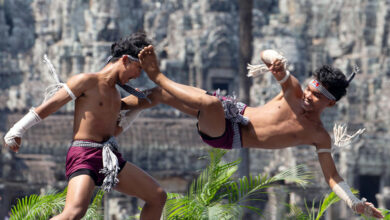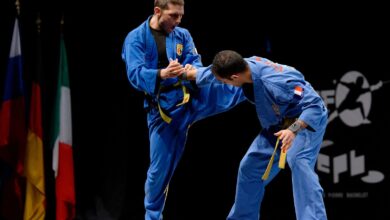
The Chinese Connection: How Fujian Martial Arts Shaped Okinawan Karate
Karate: Okinawan Karate, widely recognized as one of the most influential martial arts in the world, has deep roots in Chinese combat systems, particularly those originating from Fujian Province. One of the most significant historical documents that preserves these connections is the Bubishi, a classical manual often referred to as the “Bible of Karate”.
The Bubishi outlines combat principles, self-defense techniques, pressure point attacks, and philosophical teachings that reveal a strong influence from Fujian White Crane Kung Fu and other Southern Chinese martial arts.
This article explores how Fujian martial arts, specifically White Crane Kung Fu, shaped the techniques, training methods, and philosophies of Okinawan Karate through the Bubishi.
1. The Bubishi: A Bridge Between Chinese and Okinawan Martial Arts
The Bubishi is a handwritten martial arts manual that was passed down among Okinawan Karate masters before being published in modern times. Though its exact origins are debated, most researchers agree that the text originated from Fujian Province, where it documented the fighting techniques of Chinese martial artists.
The influence of Fujian White Crane Kung Fu is evident in the Bubishi’s:
- Striking techniques
- Footwork and stances
- Self-defense strategies
- Concept of energy and sensitivity
- Vital point striking (Kyusho-jutsu)
Karate legends such as Kanryo Higaonna, Chojun Miyagi, and Choki Motobu are believed to have studied Chinese martial arts in Fujian before returning to Okinawa and integrating these teachings into what eventually became Naha-te, Shuri-te, and Tomari-te, the foundational styles of Karate.
2. Fujian White Crane Kung Fu: The Blueprint for Okinawan Karate
One of the most direct influences on Okinawan Karate comes from Fujian White Crane Kung Fu (白鶴拳, Bai He Quan). This martial art emphasizes:
- Quick, whipping strikes resembling a crane’s beak and wings
- Deflection-based blocking techniques
- Fluid, circular movements
- Explosive counterattacks with minimal effort

Similarities Between Fujian White Crane and Okinawan Karate
Several key principles found in Fujian White Crane were directly absorbed into Karate styles, particularly Goju-Ryu and Uechi-Ryu:
| Fujian White Crane Kung Fu | Okinawan Karate (Goju-Ryu & Uechi-Ryu) |
|---|---|
| Soft, flowing movements mixed with hard strikes | Goju-Ryu’s balance of “Go” (hard) and “Ju” (soft) techniques |
| Circular blocking techniques | Uke (blocking techniques) in Karate, such as Mawashi-uke |
| Short, explosive attacks with precision | Goju-Ryu’s emphasis on short-range power strikes |
| Sensitivity training (feeling the opponent’s energy) | Kakie (sticky-hand training) in Goju-Ryu Karate |
These similarities suggest that Okinawan masters directly borrowed and adapted many White Crane Kung Fu techniques into their own system.
3. The Role of Chinese Martial Arts Masters in Okinawa
Okinawan history records that Chinese martial artists frequently traveled to the Ryukyu Kingdom as part of cultural and trade exchanges. Some of the most famous influences include:
1. Xie Zhongxiang (Ryu Ryu Ko)
- A Fujian White Crane master believed to have taught Kanryo Higaonna, the founder of Naha-te Karate (which later evolved into Goju-Ryu).
- His teachings emphasized short-range striking, controlled breathing, and body conditioning.
2. Other Fujian Masters
- Various Southern Chinese martial artists taught Okinawans in private settings, transmitting combat principles through hands-on training.
- The Bubishi is believed to contain records of these teachings, describing kata (forms), joint locks, and pressure point attacks.
This direct transmission of knowledge is what led to the fusion of Fujian martial arts with native Okinawan self-defense practices.
4. Core Principles from Chinese Martial Arts in the Bubishi
The Bubishi is filled with techniques and concepts that align closely with Southern Chinese martial arts principles. Some of these include:
1. Qi (Ki) Energy and Breathing
- Fujian Kung Fu: Uses controlled breathing techniques to generate power.
- Karate: Goju-Ryu’s Ibuki breathing and Sanchin kata focus on breath control for power and endurance.
2. Iron Body Conditioning
- Fujian Kung Fu: White Crane and Tiger-style Kung Fu focus on body toughening.
- Karate: Okinawan practitioners use Makiwara training (striking boards) and Hojo Undo (strength training).
3. Kyusho-Jutsu (Vital Point Striking)
- Fujian Kung Fu: Uses dim mak (pressure point strikes) to disable opponents.
- Karate: The Bubishi contains diagrams of vital points, which Karate masters integrated into self-defense techniques.
4. Grappling and Joint Locks
- Fujian Kung Fu: Incorporates Chin Na (joint locks and manipulations).
- Karate: Many traditional Karate kata contain hidden grappling techniques derived from Chinese Chin Na.
These elements illustrate how Chinese martial theories deeply shaped Karate’s combat principles.
5. Karate Today: A Lasting Chinese Influence
While modern Karate has developed into a distinct martial art, its Chinese origins remain evident in traditional styles such as Goju-Ryu, Uechi-Ryu, and Shorin-Ryu. Many of the katas practiced today are adaptations of Chinese forms, preserving their structure and techniques.
For instance:
- Goju-Ryu’s Sanchin Kata directly mirrors White Crane’s breathing and posture control.
- Uechi-Ryu, founded by Kanbun Uechi, is based almost entirely on Southern Chinese Tiger and Crane styles.
Even sport Karate, with its emphasis on speed and precision, still retains foundational elements from its Chinese predecessors.
A Legacy of Chinese Influence
The Bubishi serves as an enduring testament to the Chinese connection in Okinawan Karate. Fujian White Crane Kung Fu, alongside other Southern Chinese martial arts, directly influenced Karate’s techniques, training methods, and philosophical principles.
While Karate has evolved into a distinct system, its roots remain deeply embedded in Chinese martial traditions. This historical link highlights the interconnectedness of martial arts across cultures, showcasing the shared knowledge that continues to shape modern combat systems.



